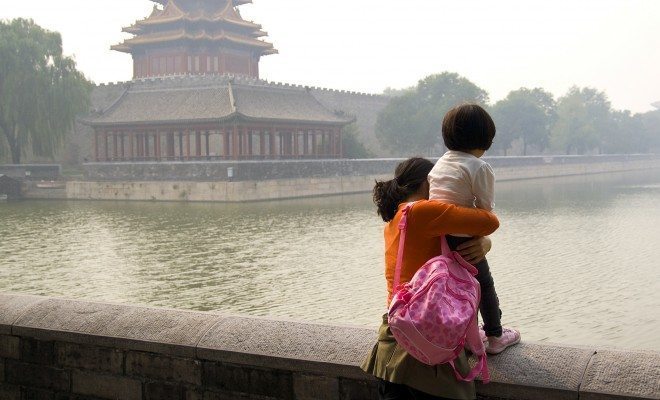 Image courtesy of [Dimitry B. via Flickr]
Image courtesy of [Dimitry B. via Flickr]
World
An End to China’s One-Child Policy: What Does it Mean?
After nearly three and a half decades, China’s famous one-child policy is finally coming to an end; the Communist Party announced last week that it will begin to allow families to have up to two children. The change will officially go into effect this upcoming March, when the parliament provides approval at its annual session. The policy, which was introduced in 1979, was meant to help ease the booming population of the country, which is now at approximately 1.36 billion. However, it has had enormous adverse effects on nearly every facet of Chinese society, and has created a chaotic demographic landscape within the country. Essentially, the Chinese population is too male, and too old, and that’s a problem.
So, why should the rest of the world care about this change in China? The one-child policy has been a human-rights disaster, and the demographic, social, and economic effects will haunt China for generations to come. Here’s an overview of what this policy has meant for Chinese society over the past 30 years, and what its end will mean for the country’s future.
The One-Child Policy: A Background
In 1949, the year of the founding of the People’s Republic of China, Mao Zedong proclaimed, “of all things in the world, people are the most precious.” This declaration reflected the government’s notion that population growth was beneficial and would help boost the economy. The government even went as far as to ban the import of contraceptives into the country in order to promote this agenda.
This backfired, however, when the population levels became so large that food supplies were not sufficient enough, resulting in famine that caused around 30 million deaths. The severity of China’s population growth became evident, and something needed to be done to slow it. As a result, the one-child policy was born in 1979 and declared that couples must limit their families to only having one child.
Violators who go over the mandated quota can face a variety of consequences, ranging from fines to forced abortions and sterilizations. There are some exceptions: ethnic minorities are generally excluded from the rule, and couples are allowed to give birth to a second child in certain circumstances. Additionally, the policy has been criticized for being applied unequally depending on one’s socioeconomic status: the rich are able to pay a “social compensation fee,” a fine that is a certain percentage of their income, or are able to travel abroad to give birth. This has turned the policy into a class issue as well, because the wealthy elite are easily excluded from the law.
Perhaps one of the greatest criticisms of the policy is how unevenly it is enforced. Regulations and consequences can vary from province to province, in addition to socioeconomic status. Critics cite this as proof that the policy is simply unenforceable; there is no way to hold everyone to the same levels of accountability and ensure that everyone is receiving equal treatment. So, the argument follows, what good is a policy that can’t even be carried out as it is supposed to be?
The consequences of the policy
In a way, it could be said that this policy has been successful: ultimately, it ended up doing what it set out to do by preventing around 400 million births. However, in doing so, it has created enormous disruptions in various facets of Chinese society. The one-child policy is essentially a social experiment that seemingly has done more harm than it has good.
Strict Regulations on Fertility
This policy has led the Chinese government to implement severe methods to regulate fertility, including forced abortions on women who become pregnant with a second child. Official statistics say that there have been approximately 1,500 abortions an hour since the implementation of the policy. Another means by which this takes place is sterilization, which is often forced—nearly 196 million of these procedures have been performed since implementation of the policy. While this sterilization is effective in ensuring that couples do not have to worry about accidental pregnancies, it is not a trouble-free solution. An example of this can be seen in a story told by one reporter, who recounted that after the 2008 earthquake in Szechuan, many couples who lost children were rushing to reverse these procedures so that they would be able to conceive again.
Additionally, there is now a generation of “hidden children” (children born out of quota) who have been abandoned by their families and are often unable to receive official identification numbers from the Chinese government. This is just one of many ways in which the policy is viewed as harmful for human rights in the country.
In some cases, women feel that their reproductive organs are owned by the state, as they no longer have sovereignty over their bodies. The tight hold that the government has over women’s bodies enhances the already-patriarchal nature in Chinese society, which exists largely due to the sheer amount of males in China.
An Altered Demographic Landscape
The one-child policy has created an imbalanced sex ratio (1.16 boys born for every girl) that is becoming problematic for Chinese society. This is because it has encouraged sex-selective practices such as abortions, infanticides, and abandonment of female babies. The statistics regarding some of these practices are heartbreaking: the rates of girls at Chinese orphanages have been found to be as high as 90 percent.
These practices have created a new generation of Chinese bachelors who are finding it difficult to marry. In some rural areas, feudal practices have reemerged that dictate that if a man wants to marry, his family must pay a large price for the girl’s hand. Many men will likely never be able to marry, having even greater ramifications for future generations.
Additionally, the population of China is skewing older, and is likely continue to do so for many generations. The average population of the country is getting older and older, and will continue to do so in the future. However, since the number of younger people is declining, there will be less people to support the growing retiree population. As the video below shows, more people must rely on nursing homes for support, going against traditional Confucian traditions that dictate that families must support their elderly members.
What makes this issue even more serious is the fact that China lacks a social security system, so children are counted on to be the source of support for parents after retirement. In the 2008 earthquake many parents who lost children were rushing to undo their sterilization procedures; one of the main reasons why is that they need someone to provide for them as they age.
Lastly, China’s aging population will potentially harm the economy in a huge way. With a shrinking working-age population, China’s economic future may be in peril.
The consequences of the one-child policy on the demography of China are serious and affect nearly every aspect of Chinese life in the present and in the future. Even with the end of the policy, it will likely take generations for these repercussions to be undone.
How will the end of this policy benefit China?
While the end of the one-child policy is a step in the right direction, it probably won’t be able to undo the disastrous consequences that were created with its implementation. More so, this change won’t be able to make up for the millions of lives affected by the forced sterilizations, abortions and infanticide that took place under this policy. And while the two-child limit still exists, a Chinese woman’s fertility will still remain under the control of the government.
In an article in The Guardian, author Mei Fong argues that the one-child policy has not solely changed the number of kids that a couple has, but has overall changed the way that Chinese people live their lives. Major life decisions such as marriage, employment, and retirement have all been shaped by the policy, and as a result, it is unlikely that the end of the policy will result in any sort of “baby boom” that will undo its negative effects. Fong’s overview demonstrates an important point: it will take a long time before Chinese society sees any effects from ending this policy. So, for a long time coming, we will likely see more of the same in China.
Conclusion
At the end of the day, the one-child policy was an ideal that could never be achieved. There is no simple answer to China’s population problems, but an authoritarian policy is obviously not the solution, and it seems that the country has finally recognized it. China will be a country to watch over the next few decades, as it struggles to figure out how to manage nearly one-sixth of the world’s total population.
Resources
BBC: China to End One-Child Policy and Allow Two
The Guardian: China’s Brutal One-child Policy Shaped How Millions Lived, Loved, and Died
National Geographic: How China’s One-Child Policy Backfired Disastrously
Wired UK: The Harrowing Reality of China’s One-child Policy
TIME: A Brief History of China’s One-Child Policy
The New Yorker: Judging China’s One-Child Policy








Comments